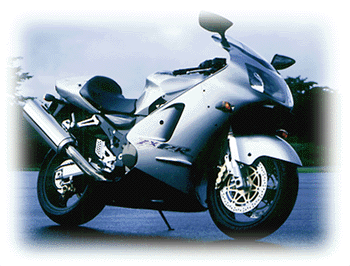Road tests

Kawasaki ZX-12R
June 2000
Kawasaki has a proud history of building big-bore road bikes that are
viciously quick. Welcome to the ZX-12R.
Its natural enemy is the Suzuki Hayabusa, and it would be a mistake
to assume the two bikes are simply a variation on each other. They are
quite different - with the Kawasaki item being more track-oriented. And
the Hayabusa is more track-oriented than the Honda Blackbird.
The Suzuki Hayabusa carries 100cc more capacity, claims three horses
less (175 at 9800rpm versus 178 at 10,500) and a bit more torque (14.1kg-m
at 7000 versus 13.66kg-m at 7500rpm). As for the chassis, the Hayabusa
is 45mm longer in the wheelbase, has a more conservative rake up front
(24.2 degrees versus 23.5) and more trail (97 versus 93mm). Oh, and the
Suzi weighs five kilos more while having a claimed five mm lower seat.
What all this adds up to is the Kawasaki has yet to win a top-speed
run against the Suzuki, but is still the only other member of the genuine
300kmh-plus club. It's also a far more nimble bike but is a lot less pillion
friendly.
The Kawasaki boasts a remarkably wide fairing (developed with the assistance
of the factory's aeronautical division, according to the blurb) which gives
a lot of protection from the elements, plus a riding position that is likely
to please more folk than most of its competitors - with less reach to the
handlebars than you might expect and more legroom.
Quick class
The steering is very quick for a bike of this class and stable at most
speeds, though it gets light at the outer reaches. Accuracy was very good,
though I'd suggest this is not a package for the faint-hearted. Once you
throw in suspension which works at speed but is hard in the suburbs, shitloads
of power, lots of brakes, and a tallish seat, this is a bike which requires
confidence and experience to ride well.
Braking is said to be very good by most other reports. Our example had
glazed brake pads, though there was no question the power was there.
Assuming the brakes are as good as most reports say, this is an easier
package to ride hard than Yamaha's R1, though I'd still be reluctant to
pick a winner from those two in a full-on track contest (with A-grade riders
on board). For most mortals, the Zex will be an easier proposition.
The ZX-12R's finish inside the fairing is very basic, while the styling
of the air scoop and mirrors up front, or muffler on the rear, need work.
They look like add-ons on a package that is otherwise slick.
There's a fair bit of vibration from the engine - not unpleasant - while
I'm surprised a bike with fuel injection would bother with a manual cold
start lever that doesn't work all that well on a cold morning. Our bike
had a tendency to stall if we backed off the lever, unless the powerplant
was given a good rev mid-warm-up.
Transmission performance and accuracy was good - about on a par with
the Hayabusa, but a little behind the Blackbird's ultra-slick set-up. Engine
vibration was a similar story.
Abso-bloody
Performance is abso-bloody-lutely spectacular. Gee, what a surprise.
Like the Hayabusa, it makes the Blackbird feel a little limp at the top-end
of the scale - say 220 kay-plus. At anything resembling double the national
speed limit (or below), you'll find the Blackbird is competitive.
If you're considering a switch from a ZZ-R1100, be prepared for a much
harder-edged and taller bike. That is eons ahead of the older model when
it comes to sporting ability, but a little behind in comfort.
At this stage I'm waiting for the second-generation versions of the
Hayabusa and ZX-12R - only because the Blackbird made a huge leap from
Gen I (carburettor version) to Gen II (injected). If Suzuki and Kawasaki
can achieve similar things, their products will be truly stunning.
The Blackbird is still the pick of the class as a refined road bike,
while the ZX-12R is now the pick as a sportbike. Suzuki's Hayabusa takes
a very fast middle ground, which I reckon is very tempting given its price.
For the time being, the ZX-12R is the sharp end of the production superbike
class. If that's what you want, go for it. The pricing - in Australia -
puts it about $3000 higher than Hayabusa, which is a big ask.
Guy Allen

Quick Specs
Displacement: 1199cc
Bore x stroke: 83 x 55.4mm
Compression ratio: 12.2:1
No. of cylinders: 4
Cooling: liquid
Max power (claimed): 178ps 10,500rpm
Max torque(claimed): 13.66 N-m 7500rpm
Primary drive type: gear
Clutch type: wet
Gears: 6
Final drive type: chain
Lubrication: wet sump
Fuel capacity: 20 litres
Carburetion: injection with manual cold-start lever
Front/rear suspension type: USD 43mm cartridge fork with rebound &
compression adjustment/gas-charged monoshock with preload, rebound and
compression adjustment
Front brakes: twin six-piston calipers on 320mm discs
Rear brake: twin-piston caliper on 230mm disc
Front/rear tyre sizes: 120/70-17, 200/50-17
Frame type: monocoque alloy with alloy subframe
Wheelbase: 1440mm
Seat height: 810mm
Rake: 23.5 degrees
Trail: 93mm
Dry/wet weight: 210/248kg
Price: $20,990 (June 2000)
[Roadtests | Motorcycle
Books]
![]()

![]()